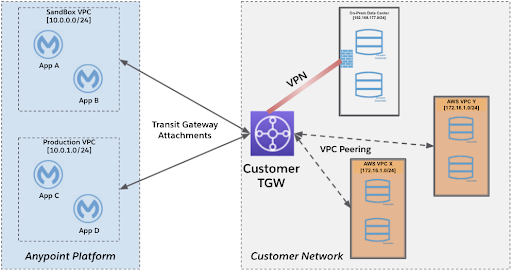Customers use CloudHub for various use cases: deploying sophisticated cross-cloud integrations, creating APIs on top of existing data sources, or integrating on-premises applications with cloud services. The key to enabling these use cases is to establish connectivity from customer AWS environments or on-premises environments to Anypoint VPC. These connections are time-consuming to set up and often delay the realization of value.
This issue is not unique to onboarding CloudHub — IT organizations with AWS and an on-premises presence face this internally as well. Over the last few years, AWS Transit Gateway has become an integral part of network management for organizations to solve this problem.
We’re excited to announce that CloudHub customers can now simplify network connectivity with AWS environments by attaching Anypoint VPCs in CloudHub to AWS Transit Gateways. The Transit Gateway acts as a cloud router. It simplifies network access between VPCs, on-premises environments, or third-party software while providing increased visibility and control over the network. Transit Gateways effectively merge an organization’s cloud resources and on-premises data centers into one network topology.
In a few simple steps, an Anypoint VPC connects to the central hub of your network within AWS. Once attached, your network team has control over providing Anypoint VPC with access to your AWS VPCs or datacenters that are already attached to the Transit Gateway in a simple, reusable, and compliant manner.
Cross-cloud connectivity, simplified
Let’s take an example where you have created a sandbox Anypoint VPC in CloudHub and deployed a few applications to it. In this mock use case, Mule App A needs to connect to services running in your AWS VPCs X and Y and App B requires a connection to an on-premises database.
To enable these use cases, you need two VPC peering connections from Anypoint VPC to AWS VPCs X and Y, as well as a VPN or Direct Connect connection to your on-premises environment. You coordinate with your networking team and set up these connections. The end goal is to go to production, so the same connections need to be made for your production Anypoint VPC. The point-to-point connections add up and so does the time it takes to set everything up.

With the AWS Transit Gateway, this connectivity is simplified.
Your AWS VPCs and on-premises environments can be connected to your AWS Transit Gateway. From Runtime Manager, you can connect your CloudHub VPC to your AWS Transit Gateway with a few simple steps (see documentation). The AWS Transit Gateway becomes the hub of your network and your network team can provide the CloudHub VPC access to the AWS VPCs and on-premises networks within the compliance and networking rules of your organization (as seen in the diagram below).

Want to learn more?
Get started today connecting your Cloudhub VPCs to AWS Transit Gateway:
- Documentation with step-by-step instructions
- More information on AWS Transit Gateway from AWS









